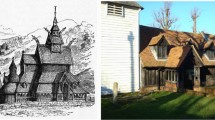The building technology on permafrost foundations using a heat-insulating pad made of granulated foam-glass ceramic is considered. The influence of the pad on the temperature regime of the frozen base of a dome-type residential building was studied using computer modeling. The design parameters of the insulating pad were established to ensure the thermal stabilization of the frozen base for 30 years. A technical and economic assessment of the new technology is given, taking into account the production of thermal insulation based on Arctic raw materials: opal-cristobalite rocks and zeolites.
Similar content being viewed by others
References
G. V. Anikin, K. A. Spasennikova, S. N. Plotnikov, and A. A. Ishkov, “Method for stochastic prediction of soil temperature using GET systems,” Soil Mech. Found. Eng., 54, 65-70 (2017), doi:https://doi.org/10.1007/s11204-017-9435-7.
V. P. Melnikov, G. V. Anikin, and K. A. Spasennikova, “Operation of thermosyphons beneath an oil tank at the Varandey field: prediction by stochastic analysis,” Earth Cryosphere, 23, No. 1, 64-71 (2019), doi: https://doi.org/10.21782/KZ1560-7496-2019-1(63-71).
T. A. Kornilov, A. Ya. Nikiforov, and M. V. Rabinovich, “Monitoring of permafrost foundation-bed soils of low-rise buildings having unvented underfloor spaces,” Soil Mech. Found. Eng., 57, 336-342 (2020), doi: https://doi.org/10.1007/s11204-020-09675-y.
D. V. Makarov, N. K. Manakova, and O. V. Suvorova, “Production of rock-based foam-glass materials (review),” Glass and Ceramics, 9, 411-416 (2023), doi: https://doi.org/10.1007/s10717-023-00522-8.
E. A. Yatsenko, B. M. Goltsman, L. V. Klimova, and L. A. Yatsenko, “Peculiarities of foam glass synthesis from natural silicacontaining raw materials,” J. Therm. Anal. Calorim., 142, 119-127 (2020), doi; https://doi.org/10.1007/s10973-020-10015-3.
B. M. Goltsman, L. A. Yatsenko, and N. S. Goltsman, “Production of foam glass materials from silicate raw materials by hydrate mechanism,” Solid State Phenomena, 299, 293-298 (2020), doi: https://doi.org/10.4028/www.scientific.net/SSP.299.293.
V. T. Erofeev, A. I. Rodin, A. S. Kravchuk, S. V. Kaznacheev, and E. A. Zaharova, “Biostable silicic rock-based glass ceramic foams,” Civ. Eng., 84, 48-56 (2018), doi: https://doi.org/10.18720/MCE.84.5.
A. P. Astapov, V. V. Borovsky, and A. S. Voronin, “The North Tyumen subprovince of cristobalite-opal rocks is a unique mineral resource base of the West Siberian industrial complex,” Vestnik Nedropolzovatelya, No. 14, pages? (2004).
K. E. Kolodeznikov, Zeolite-Bearing Provinces of the Eastern Siberian Platform [In Russian], Nauka, Novosibirsk (2003).
V. P. Melnikov, A. A. Melnikova, and K. S. Ivanov, “The use of granular foam-glass ceramics in the Arctic construction of low-rise buildings,” Arctic: Ecology and Economics, 12, No. 1, 271-280 (2022), doi: https://doi.org/10.25283/2223-4594-2022-1-271-280.
P 313.1325800.2017, Roads in Eternal Permafrost Regions. Rules for Design and Construction [in Russian], Standartinform, Moscow (2018).
V. I. Ruvinskii, Manual on the Arrangement of Heat-Insulating Layers from Styrofoam on Russian Roads [in Russian], Transport, Moscow (2000).
STO 36554501-012-2008, Use of Thermal Insulation from PENOPLEX® Foamed Polystyrene Extrusion Plates in the Design and Construction of Shallow Foundations on Heaving Soils [in Russian], NITs Stroitelstvo, Moscow (2008).
SP 25.13330.2012. Foundations on Permafrost Soils [in Russian], FCS, Moscow (2012).
SP 131.13330.2012 Construction Climatology [in Russian], FCS, Moscow (2015).
I. Inzhutov, V. Zhadanov, P. Melnikov, and S. Amelchugov, “Buildings and constructions on the base of timber for the Arctic Regions,” E3S Web of Conferences, 110, Article No. 01089 (2019), doi: https://doi.org/10.1051/e3sconf/201911001089.
G. Cheng, Z. Sun, and F. Niu, “Application of the roadbed cooling approach in Qinghai–Tibet railway engineering,” Cold Reg. Sci. Tech., 53, 241-258 (2008), doi: https://doi.org/10.1016/j.coldregions.2007.02.006.
S. Coulombe, D. Fortier, and E. Stephani, “Using air convection ducts to control permafrost degradation under road infrastructure: beaver creek experimental site, Yukon, Canada,” 15th International Conference on Cold Regions Engineering (2012), doi:https://doi.org/10.1061/9780784412473.003.
Y. Cao, G. Li, G. Wu, D. Chen, K. Gao, L. Tang, H. Jia, and F. Che, “Proposal of a new method for controlling the thaw of permafrost around the China–Russia crude oil pipeline and a preliminary study of its ventilation capacity,” Water, 13, Article No. 2908 (2021),. doi: https://doi.org/10.3390/w13202908.
Patent 2792466 Russian Federation “Autonomous cooling device” [in Russian].
Author information
Authors and Affiliations
Corresponding author
Additional information
Translated from Osnovaniya, Fundamenty i Mekhanika Gruntov, No. 6, November-December, 2023.
Rights and permissions
Springer Nature or its licensor (e.g. a society or other partner) holds exclusive rights to this article under a publishing agreement with the author(s) or other rightsholder(s); author self-archiving of the accepted manuscript version of this article is solely governed by the terms of such publishing agreement and applicable law.
About this article
Cite this article
Ivanov, K.S. The Impact of a Heat-Insulating Pad on the Temperature Regime of the Frozen Base of a Low-Rise Residential Building. Soil Mech Found Eng 60, 581–587 (2024). https://doi.org/10.1007/s11204-024-09932-4
Published:
Issue Date:
DOI: https://doi.org/10.1007/s11204-024-09932-4




